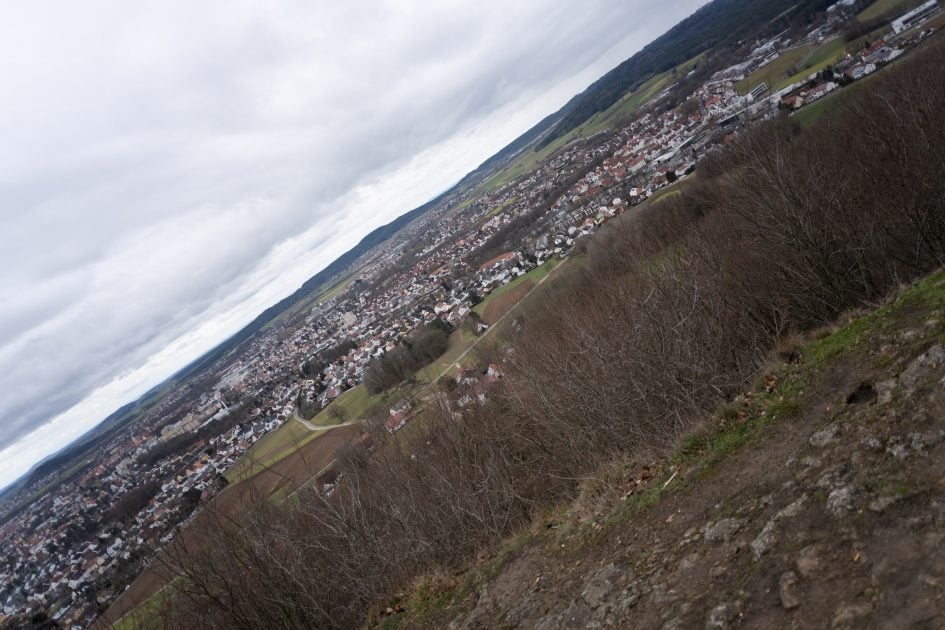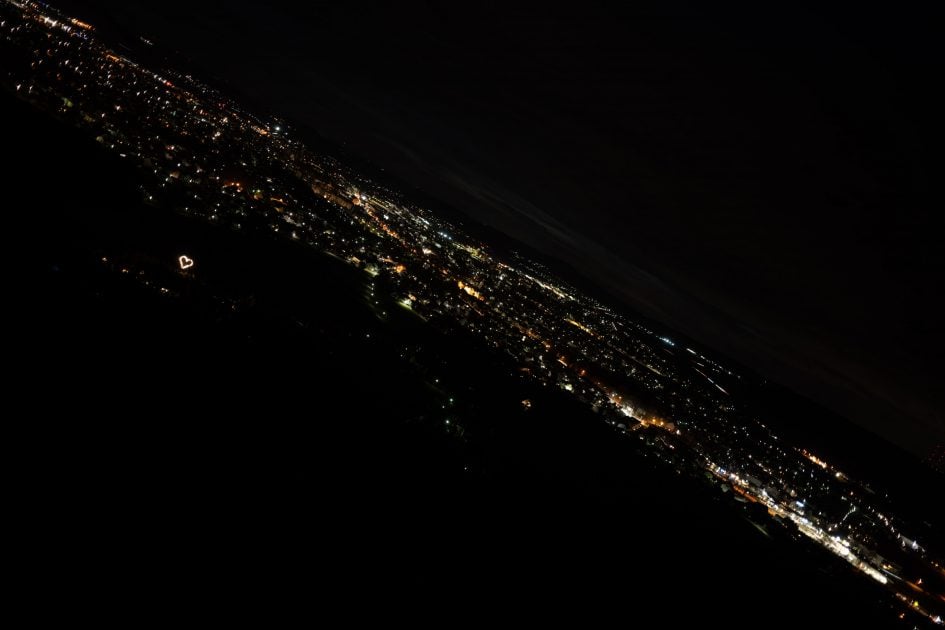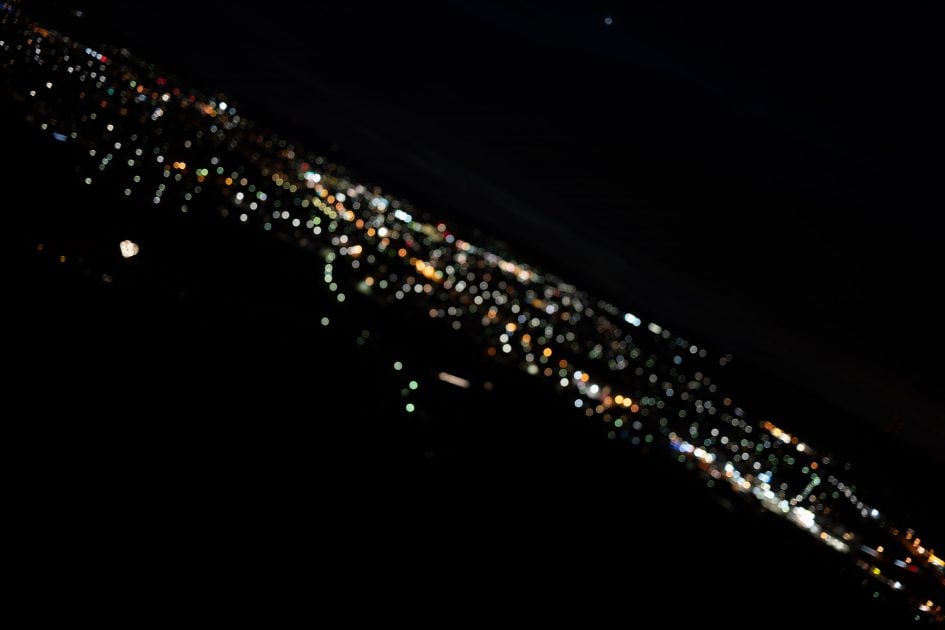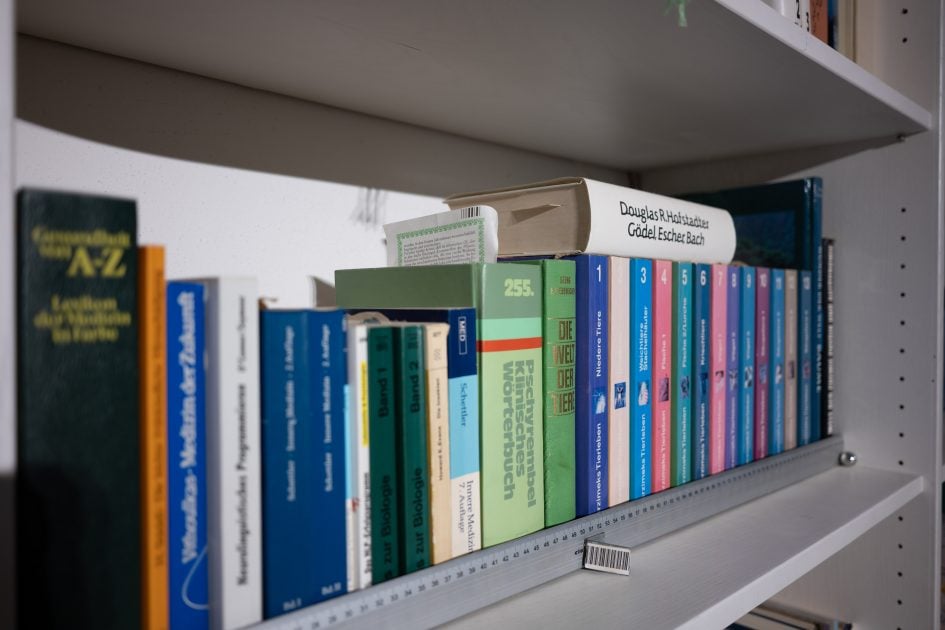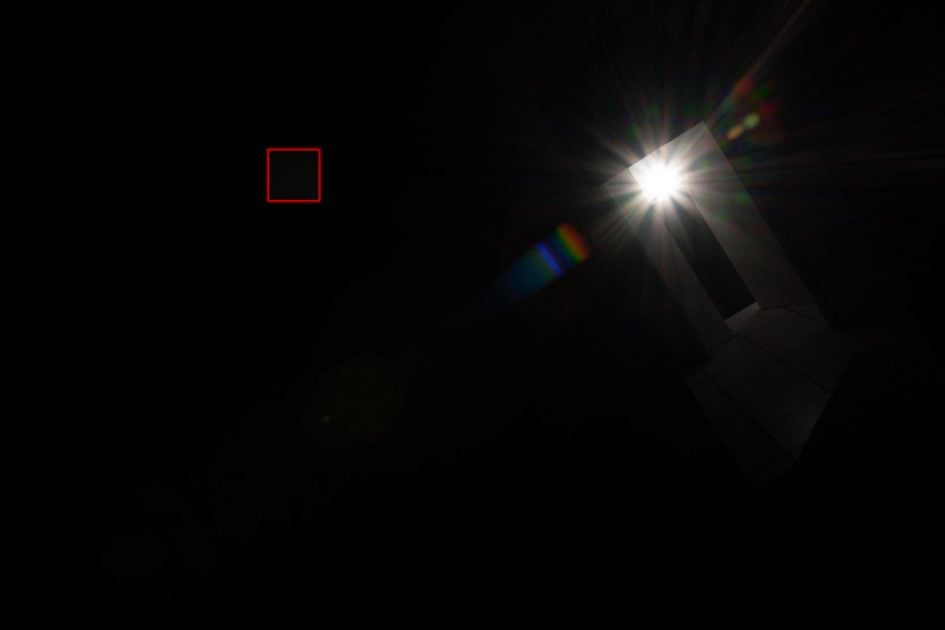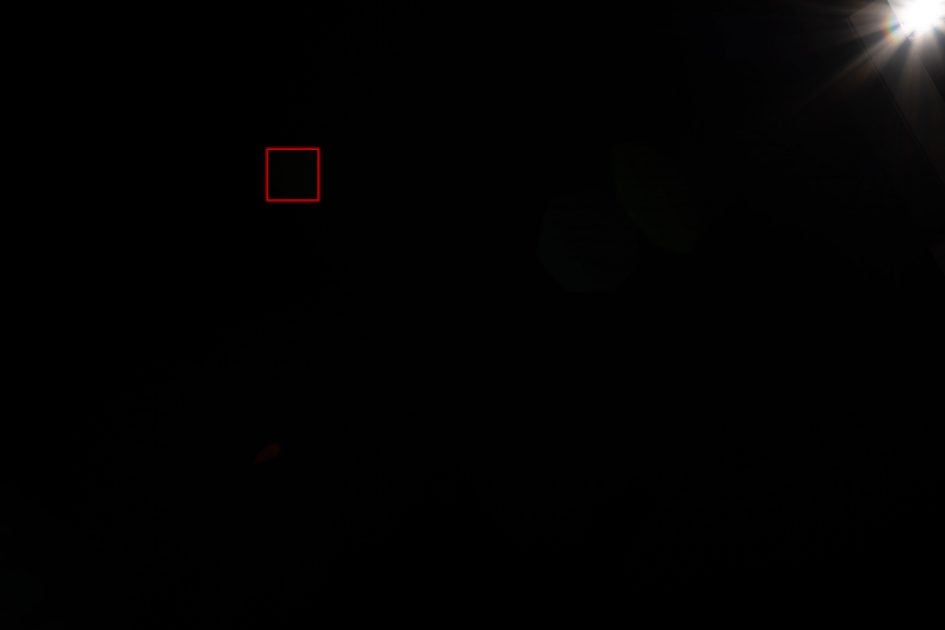Nikon Z 26mm f2.8 review
-
-
Written by Thomas
Quality
Longitudinal Chromatic Aberration and focus shift
Lenses with focal ratios of f2.8 or larger are often prone to longitudinal color aberrations (loCA, a.k.a. “axial color” or “bokeh CA”). These show up as magenta coloration in the foreground and greenish hues in the background and are not easily corrected in post-processing. The Nikon Z 26mm f2.8 shows a bit of loCA wide open. And there’s also some focus shift which makes the foreground less sharp when stopped down to f5.6.
Nikon Z 26mm f2.8 longitudinal Chromatic Aberration (loCA)
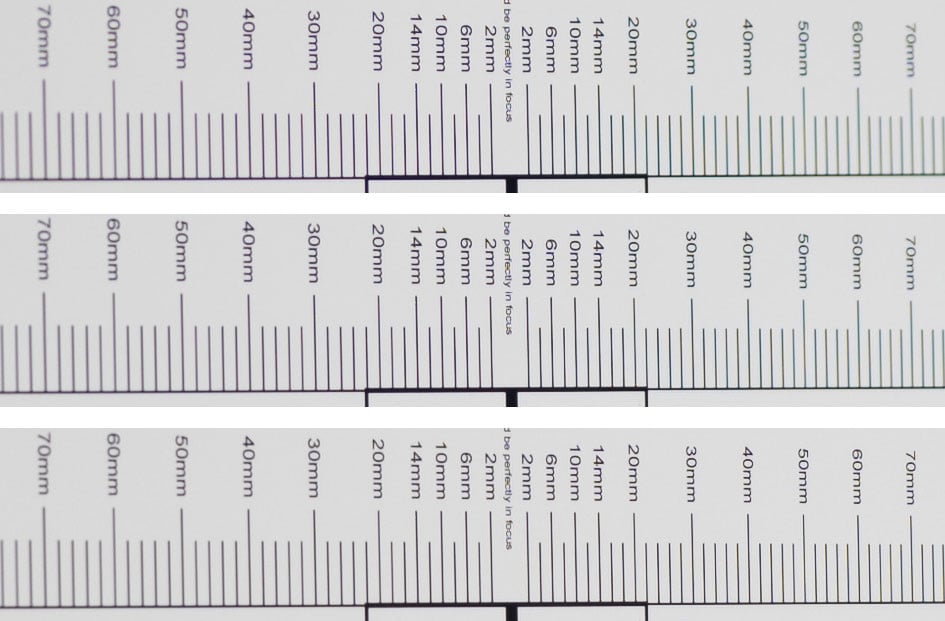
Above from top to bottom: f2.8, f4.0, f5.6; 100% crops, left = foreground, right = background
The following real life shot shows only a bit of purple fringing around high-contrast edges but some bleeding of bright light into the shadows:
Above: Nikon Z 26mm f2.8 at f2.8; 100% crop, click image for 4k version, here for large original
Sharpness and contrast
Let’s have a look at the theoretical performance of the Nikon Z 26mm f2.8 first and compare it to other alternatives from Nikon’s Z line-up:
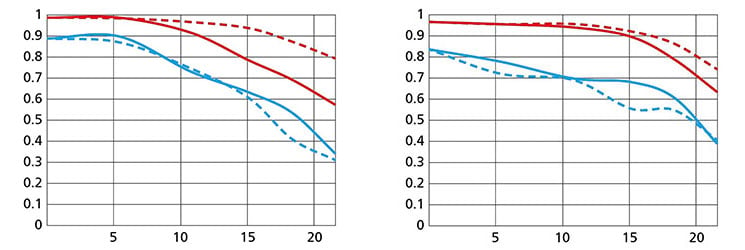
Above: Nikon Z 26mm f2.8 (left), Nikon Z 28mm f2.8 (right)
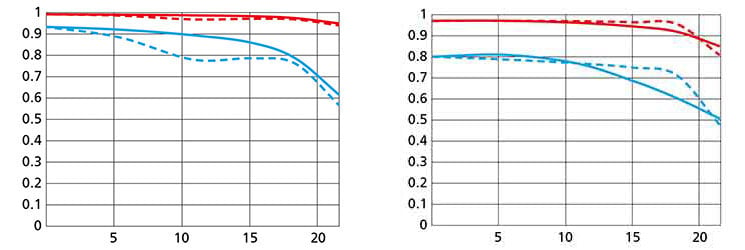
Above: Nikon Z 24-50mm f4-6.3 at 24mm f4.0 (left), Nikon Z 24mm f1.8 S (right)
These MTF charts show the computed lens-performance of lenses wide open at infinity without influence of diffraction at 10 line-pairs/mm (red) and 30 lp/mm (blue). Higher values are better (more contrast) and the closer the dotted and solid lines are together the less contrast dependents on the orientation of the test-pattern (less astigmatism). The x-axis displays the distance from the optical axis (=center of the sensor) in mm. I’ll show you the real-life performance at 4 mm (“center”), 13 mm (DX-corner), and 20 mm (FX-corner) on a 45MP Nikon Z7 camera.
From the MTF-chart the new Z-Nikkor should be very sharp in the center up to 8mm image height but the corners of the DX image-circle already suffer from lower overall contrast and loss of fine detail. And contrast drops further towards the FX-corner. The Z 28mm f2.8 clearly looks a bit softer in the center but should keep up similar levels of contrast and detail towards the corners. The Z 24-50mm f4-6.3 looks better than the other lenses but is shows here at f4.0. And the Z 24mm f1.8 S is shown at f1.8 and improves quite a bit when stopped down to f2.8.
Let’s see how this theoretical performance translates into real life results in the sharpness test based on Siemens-stars. Shooting distance was 45x focal length i.e. at around 1.3m. Processing was done in Lightroom 12.2/CRAW 15.2 from RAW to Adobe Color profile with the built-in lens profile compensating CA, vignetting, and distortions. Noise-reduction is set to 0, sharpening to 50/0.5/36/10, with no extra tone, color, or saturation adjustment. White-balance was adjusted to a neutral white and I did some exposure compensation to make the brightness of all crops match. So you will not see light fall-off in the corners.
The following 100% crops show the Nikon Z 26mm f2.8 from f2.8 down to f8 compared to the Nikon Z 28mm f2.8, Z 24mm f1.8 S and Z 24-50mm f4-6.3. To eliminate focus shift I re-focussed for each crop when stopping the lens down (up to f5.6).
Nikon Z 26mm f2.8 compared; 100% crop from center, APS-C/DX-corner, FF/FX-corner

Above: Nikon Z 26mm f2.8 at f2.8

Above: Nikon Z 28mm f2.8 at f2.8; also available at f4.0, f5.6, f8.0, f11

Above: Nikon Z 24mm f1.8 S at f2.8; also available at f1.8, f2.0, f4.0, f5.6, f8.0, f11

Above: Nikon Z 26mm f2.8 at f4.0

Above: Nikon Z 24-50mm f4-6.3 at 24mm f4.0; also available at f5.6, f8.0, f11

Above: Nikon Z 26mm f2.8 at f5.6; also available at f8.0
Wide open Nikon’s Z 26mm f2.8 is sharper in the center than the Z 28mm f2.8 and only slightly behind the Z 24mm f1.8 S. Its DX-corner even resolves a bit more detail than the 24mm lens. In the FX-corner the 26mm has the least contrast of the three lenses and shows strong coma. Stopping the Z 26mm f2.8 down to f4.0 visibly improves contrast in the DX- and FX-corner. Interestingly the 24-50mm zoom lens easily keeps up with the Z 26mm f2.8 with a slightly softer DX-corner but a better FX-corner. The test also showed that the Z 26mm f2.8 has some field-curvature but not as strong as the Z 28mm f2.8 while the Z 24mm f1.8 S and Z 24-50mm are practically free of it.
Performance at long distances
The Siemens-star test-targets are shot at a distance of 45x focal length (i.e. at around 1.2m). But performance of lenses also depends on the shooting distance. Therefore, I present another series of images shot on a 45MP Nikon Z 7 of a city around 1 km away. Processing was done in Lightroom 12.2/CRAW 15.2 from RAW to Adobe Color profile with the built-in lens profile compensating CA, vignetting, and distortions. Noise-reduction is set to 0, sharpening to 50/0.5/36/10, with no extra tone, color, or saturation adjustment. All shots were made from a heavy tripod with image stabilization switched off at ISO 64. To avoid the effect of focus shift I re-focussed when stopping the lens down (up to f5.6). And as usual I have selected the diagonal that provided the better corner results as the lens was a bit decentered.
The following images show the complete scene wide open plus 100% crops from the center, APS-C/DX-corner, and FF/FX-corner. As the corners suffer from strong light fall-off even with vignette control set to Normal I lifted them in post-processing by +60 at f2.8, +30 at f4.0, +20 at f5.6, and +10 at f8.0 to make it easier to judge and compare sharpness. You can access the large originals but please respect our copyright and only use those images for personal use.
Nikon Z 26mm f2.8
Above: Nikon Z 26mm f2.8 at f2.8, click image for 4k version, here for large original
Above: Nikon Z 26mm f2.8 at f2.8; 100% crops, click image for 4k version, here for large original

Above: Nikon Z 26mm f2.8 at f4.0

Above: Nikon Z 26mm f2.8 at f5.6; also available at f8.0
Center sharpness of the Z 26mm f2.8 is very good even wide open but the DX-corner profits visibly from stopping down to f4.0. The FX corner only becomes better at f5.6 but lacks fine detail even at f8.0.
Vignetting and distortions
To make it easier to see light fall-off in the corners of a full-frame sensor I’ve arranged a series of three shots each with the new Z-Nikkor from f2.8 to f5.6 and focused to infinity. All images were developed to the same brightness in the center and are shown with vignette control Off (1st row) resp. Normal (2nd row):
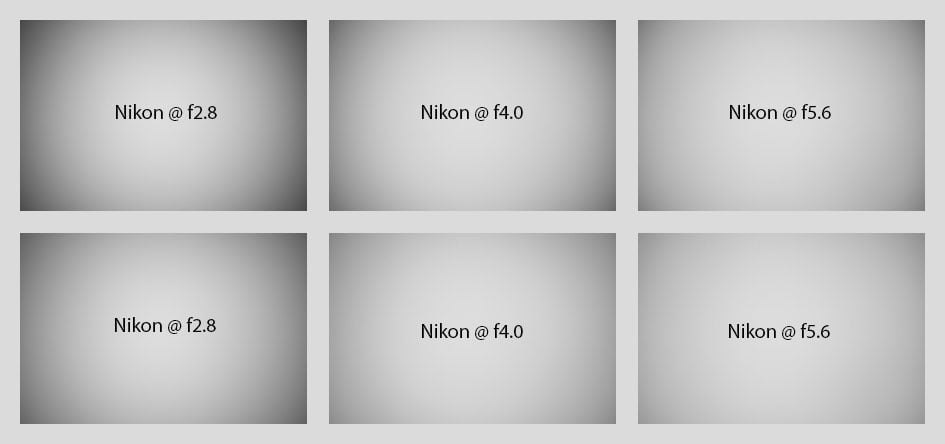
Above: Nikon Z 26mm f2.8 on a full-frame (FX) camera without vignette control (top) / vignette control set to Normal (bottom)
The sample images above show that even with the lens profile applied vignetting is very visible at f2.8 with over -2 EV fall-off. Strangely vignette control set to Normal only lifts the extreme corners by about 0.5 EV which makes me wonder whether Nikon has accidentally put a wrong (too low) parameter into the lens profile. From f4.0 onwards light fall-off is better but still clearly visible.
Adobe’s RAW converter automatically applies Vignette control as it was set in camera – but you cannot alter the setting in postprocessing. With distortions you even cannot change the setting in camera: They are always (well) corrected by the lens profile. The following image shows the upper half of a large screen TV set displaying grid lines for the full frame and cropped frame (shot as RAW and developed in Lightroom 12.2/CRAW 15.2):
Distortions: Nikon Z 26mm f2.8 with auto distortion control On
Rendering of point-light sources at night-shots
Night-shots pose a different challenge for lenses as the contrast is even higher than under bright sun and point-light sources can reveal some weaknesses such as coma, haloing and colour-aberrations that do not show up as prominently in other test-shots. The 100% crops below the main image show the effect of coma in the FX-corner of the Nikon Z 26mm f2.8 at different apertures:
Above: Nikon Z 26mm f2.8 at f2.8; click image for 4k version, here for large original

Above: Nikon Z 26mm f2.8; 100% crops from the FX-corner at f2.8 (left), f4.0 (middle), f5.6 (right)
The Nikon Z 26mm f2.8 produces very visible coma in the FX-corner (and even the DX-corner) wide open. Stopping down to f4.0 eliminates coma in the DX-corner but the FX-corner requires stopping down to f5.6 to get rid of coma.
Bokeh quality
This test is for the rendering of point-light sources in an out-of-focus background. The circle of confusion that is produced by this test is pretty indicative of Bokeh performance (in the background) and light fall-off. Ideally the out-of-focus image of the point-light is evenly lit and perfectly circular, with no “onion-rings”, and without coloration. Large aperture lenses normally produce an effect known as “cat’s eye” the further away from the optical axis the point-light is projected. This is due to optical vignetting in the lens barrel when light enters the lens from an angle.
The crops below the main image are from the center, DX-corner, and FX-corner resized to make them comparable across all my reviews.
Above: Nikon Z 26mm f2.8 at f2.8; click image for 4k version
Above: Nikon Z 26mm f2.8 at f2.8; click image for 100% crop
Above: Nikon Z 26mm f2.8 at f4.0; click image for 100% crop
Above: Nikon Z 26mm f2.8 at f5.6; click image for 100% crop
The diameter of the Bokeh balls in the center is determined by the entrance pupil of the lens which is only 9mm. So it’s no surprise that the Z-Nikkor produces very small Bokeh balls. There’s also strong outlining and some onion rings but no coloration from loCA. Bokeh balls stay well-rounded until f5.6.
Let’s see how this analysis of out-of-focus point-light sources translates into Bokeh-performance shooting a book-shelf. Crops are from the foreground, middle-ground, and background resized to make them comparable across all my reviews.
Above: Nikon Z 26mm f2.8 at f2.8; click image for 4k version, here for large original
Above: Nikon Z 26mm f2.8 at f2.8; click image for 4k version, here for large original

Above: Nikon Z 28mm f2.8 at f2.8; click image for 4k version, here for large original
Above: Nikon Z 24mm f1.8 S at f1.8; click image for 4k version, here for large original

Above: Nikon Z 24-50mm f4-6.3 at 50mm, f6.3; click image for 4k version, here for large original
Bokeh of the Nikon Z 26mm f2.8 and Z 28mm f2.8 look pretty similar with the 28mm lens rendering the slightly softer out-of-focus areas. As is to be expected the Z 24mm f1.8 S produces the best Bokeh of the four lenses in this comparison and the Z 24-50mm zoom lens has the least attractive Bokeh due to its slow focal ratio.
Looking at another crop (now at 100%) from the same images showing the ruler reveals the Nikon Z 26mm f2.8 producing slightly stronger double contours than the Z 28mm f2.8.

Above: Nikon Z 26mm f2.8 at f2.8; click image for 4k version, here for large original
Above: Nikon Z 28mm f2.8 at f2.8; click image for 4k version, here for large original
Above: Nikon Z 24mm f1.8 S at f1.8; click image for 4k version, here for large original

Above: Nikon Z 24-50mm f4-6.3 at 50mm, f6.3; click image for 4k version, here for large original
Close-up performance
The Nikon Z 26mm f2.8 goes down to 1:4.7 magnification. The following images were shot at 1:4.9 magnification where the area of sharp focus is just 118 x 177mm. The 100% crops shown below are from 0mm, 11mm, and 20mm off the center of the sensor respectively. For the following crops I focused once on the center wide open and did not change focus: Each row of crops is from the same shot, focused optimally for the center. So this is the best results you can get from a single shot as any issues with field curvature show up here.
Nikon Z 26mm f2.8; 100% crop from center, DX-corner, FX-corner

Above: Nikon Z 26mm f2.8 at f2.8, 1:4.9

Above: Nikon Z 26mm f2.8 at f5.6, 1:4.9

Above: Nikon Z 26mm f2.8 at f11, 1:4.9
As with my other tests the Z 26mm f2.8 produces a sharp center even wide open but the corners profit visibly from stopping down. Still, at f5.6 the DX-corner retains some softness. This is due to field curvature which is stronger at close-up shooting than at normal distances. See the following crops where I focused individually for each crop. The results are clearly sharper. So, once stopped down to f5.6 (or beyond) the Z 26mm f2.8 can capture very satisfying close-up shots of “normal” three-dimensional subjects. In that respect it is clearly better than the Z 28mm f2.8. Just don’t expect it to excel in reproducing flat objects.

Above: Nikon Z 26mm f2.8 at f5.6, 1:4.9
Flare, ghosting, and sunstars
Catching a strong light-source shining directly into the lens is always a risky business: it could produce strange colorful ghost-images or reduce contrast considerably through flare and glare. The appearance of flare and ghosting depends on factors like the aperture and the angle of the light hitting the lens. To judge the proclivity of Nikon’s Z 26mm f2.8 for these artifacts I went through a series of well calculated shots against a strong light-source to provoke glare and ghosting. Following are two example results. The little bright square inset in the upper left shows the respective area with an exposure compensation of +3 EV to make it easier to see which levels of black the lens renders at that point:
Above: Glare and ghosting from strong light hitting the Nikon Z 26mm f2.8 at f2.8; click image for 4k version or here for +3 EV exposure compensation
Above: Flare from strong light hitting the Nikon Z 26mm f2.8 at f11; click image for 4k version or here for +3 EV exposure compensation
The Nikon Z 26mm f2.8 produces some colorful flares but the blacks stay deep black even in adverse contra light situations.
The lens starts producing sunstars only from f5.6 onwards:

Above: Sunstars from the Nikon Z 26mm f2.8 at f4.0, f5.6, f8.0 (from left to right), 100% crops
Next check out my sample images!
Check prices on the Nikon Z 26mm f2.8 at B&H, Adorama, WEX UK or Calumet.de. Alternatively get yourself a copy of my In Camera book, an official Cameralabs T-shirt or mug, or treat me to a coffee! Thanks!
